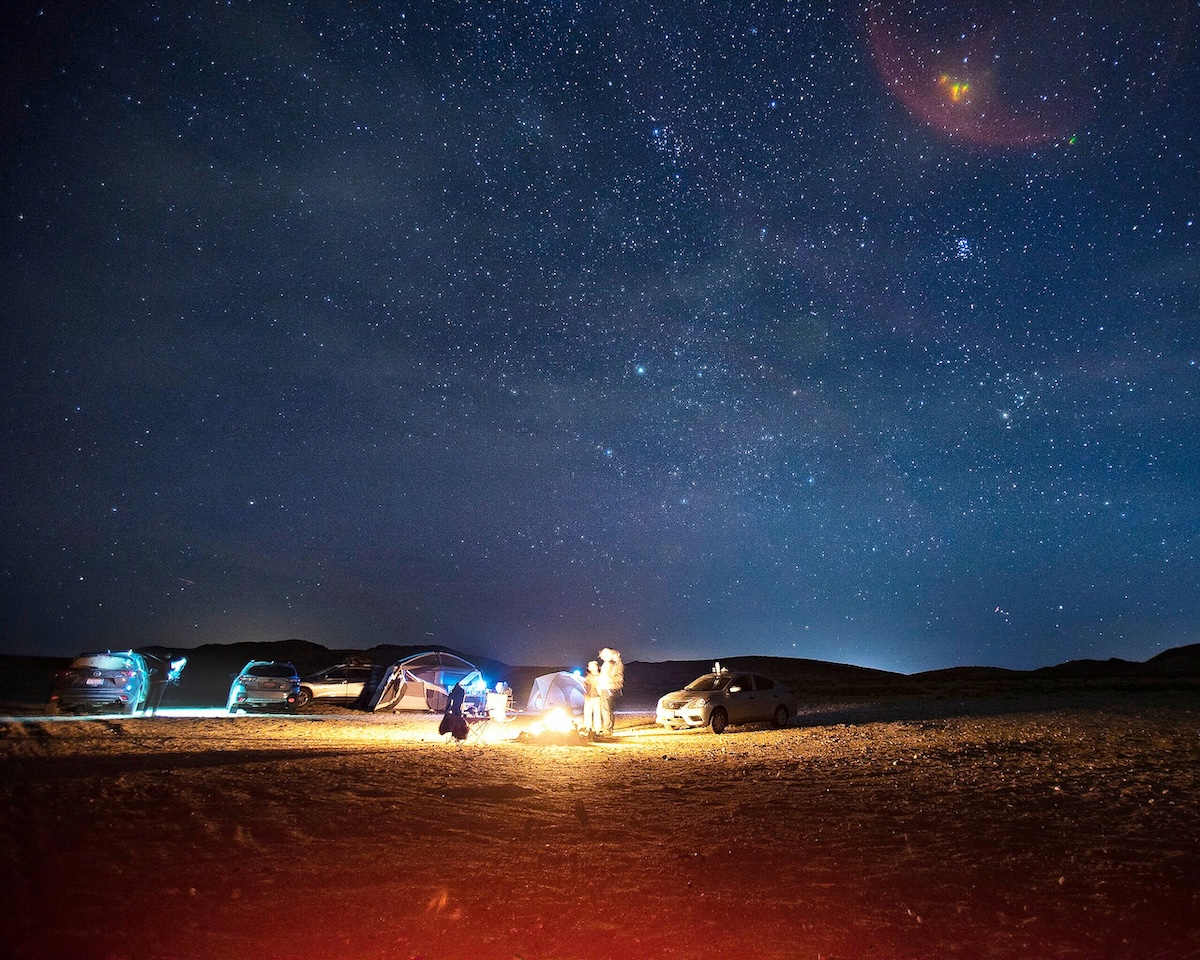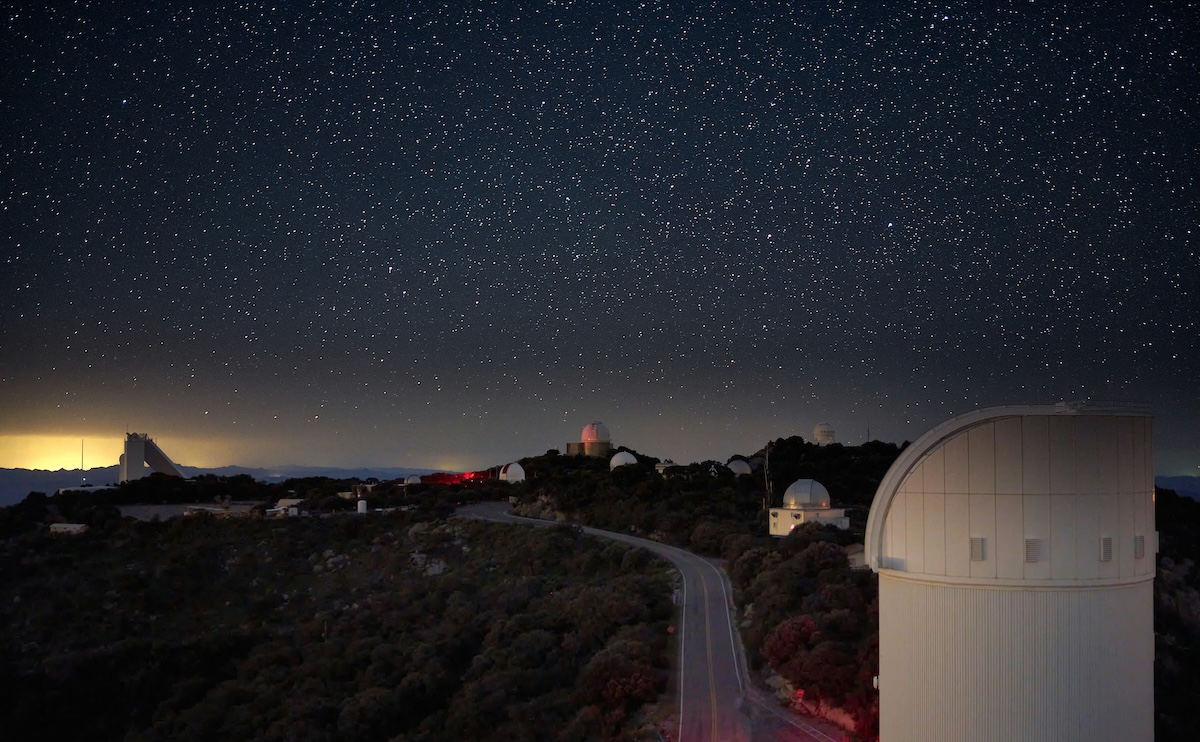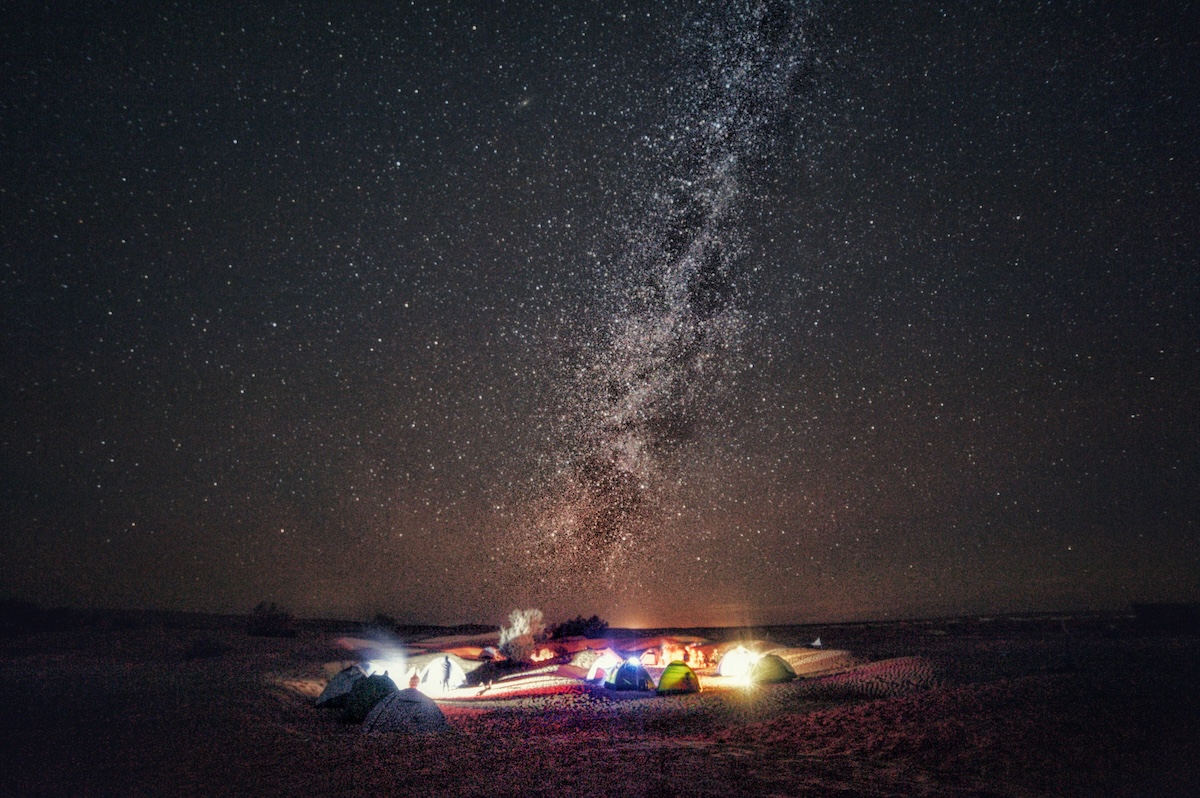
Desert Camping and Stargazing: Your Guide to Celestial Adventures in America’s Arid Landscapes
By: Mike Coleman
Skip to Section
- Article Summary
- Why Desert Environments Offer Superior Stargazing
- Top Desert Stargazing Destinations in America
- Essential Gear for Desert Stargazing Camps
- Desert Stargazing Techniques and Tips
- Desert Camping Safety and Etiquette
- Seasonal Desert Stargazing Highlights
- Planning Your Desert Stargazing Adventure
- Desert Astronomy Events and Communities
Article Summary
Stargazing in the desert is one of the clearest ways to see the universe without a telescope in your living room. This guide shows you how to turn that night sky into your personal planetarium, all while camping under it.
You’ll get a full breakdown of where to go, what to pack, and how to make sure you’re not freezing, sunburned, or squinting at a blurry sky. Whether you’re chasing meteor showers or just want to spot Saturn with your kids, this guide helps you prep like a pro and camp without wrecking the ecosystem—or your neck.
- Top spots include Death Valley, Joshua Tree, Big Bend, Great Basin, and other remote parks with little to no light pollution.
- You’ll need more than a sleeping bag—think red flashlights, star maps, zero-gravity chairs, and at least a gallon of water per person per day.
- Photography tips cover everything from camera settings to how to light a cactus without ruining someone else’s view.
- Seasonal sky guides show what constellations, meteor showers, and star clusters to look for during each part of the year.
- Safety and etiquette matter—this includes wildlife awareness, dark sky rules, and not blasting music across a silent canyon at midnight.
The desert transforms at night. As the scorching sun dips below the horizon, the vast arid landscape cools rapidly, revealing a celestial theater overhead that urban dwellers rarely experience. The combination of high elevation, minimal light pollution, and clear, dry air creates perfect conditions for stargazing. When you add camping to this experience—sleeping under that same star-studded sky—you create memories that will last a lifetime.
This guide takes you through the highlights you need to know about combining desert camping with stargazing across the American Southwest and beyond, from the best locations to essential gear and techniques for capturing the perfect night sky photograph.
Why Desert Environments Offer Superior Stargazing
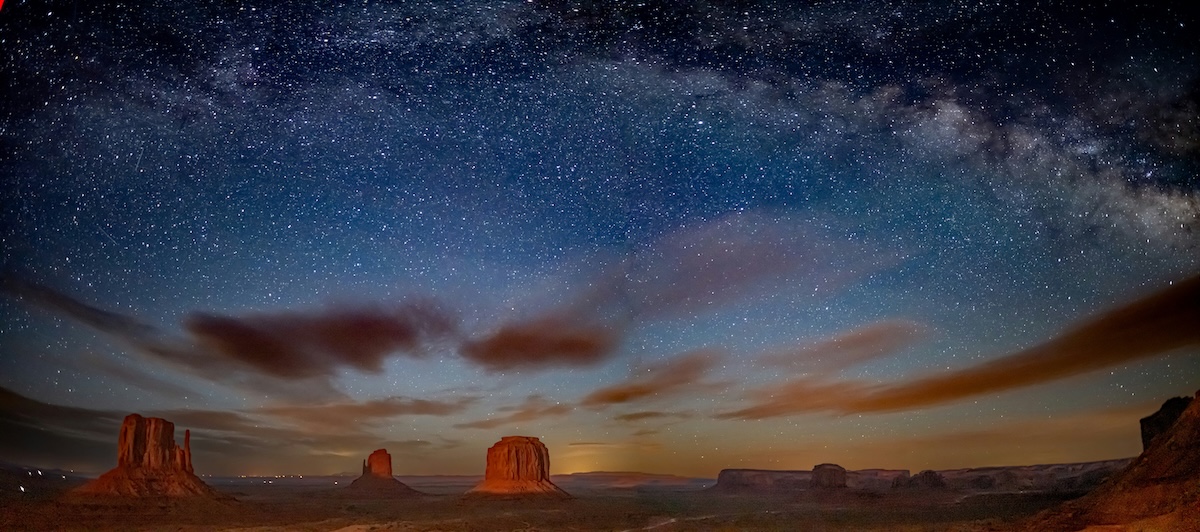
The night sky over Monument Valley – photo by Joseph Corl on Unsplash
Deserts provide ideal stargazing conditions for several scientific reasons:
Low Humidity: Desert air contains minimal moisture, which means less interference between your eyes and the stars. Water vapor scatters light, so the drier the air, the clearer the celestial objects appear.
High Elevation: Many American deserts sit at higher elevations, placing observers physically closer to the stars with less atmosphere to look through.
Minimal Light Pollution: The remote nature of desert landscapes means fewer cities and towns creating the artificial glow that washes out the night sky.
Temperature Differential: The rapid cooling that occurs after sunset in desert environments creates more stable air conditions, reducing the atmospheric turbulence that can make stars appear to twinkle excessively and blur observations.
These factors combine to create viewing conditions where even casual observers can see celestial features like the Milky Way’s structure, nebulae, and distant galaxies with minimal equipment.
Top Desert Stargazing Destinations in America
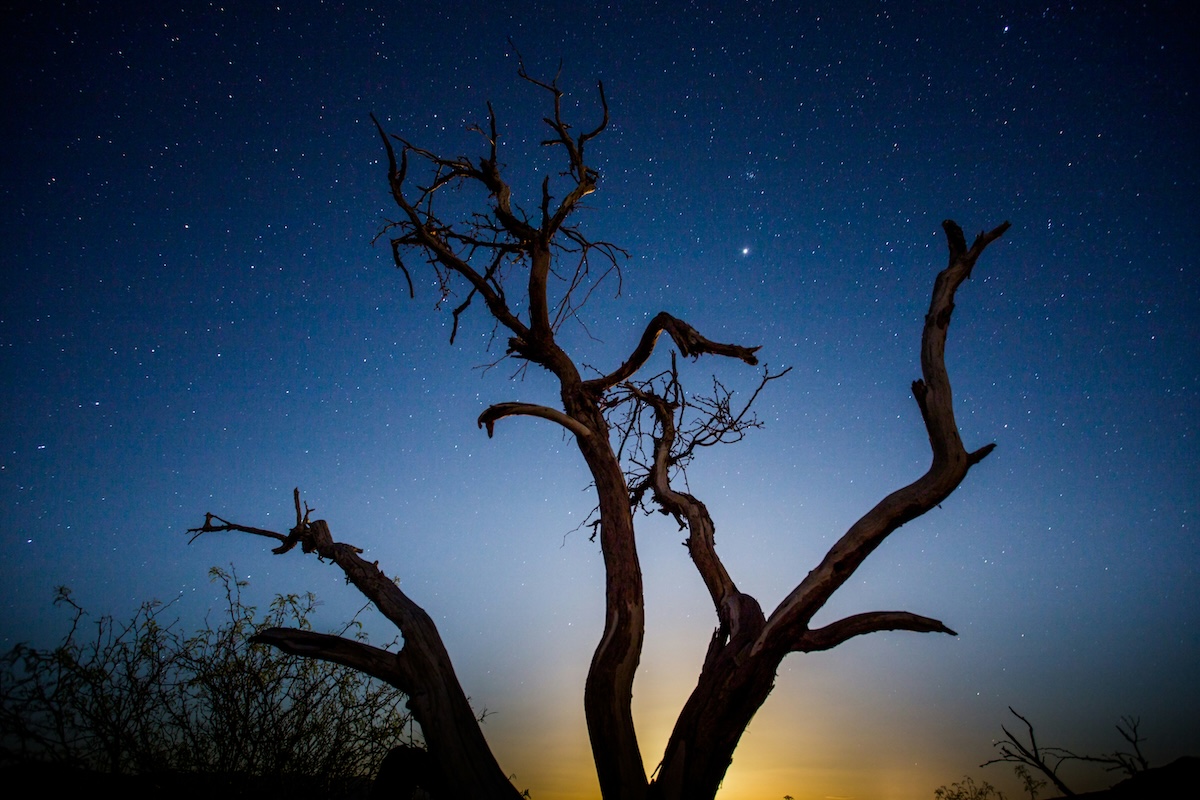
A tree at Death Valley National Park – photo by Wolf Schram on Unsplash
Death Valley National Park, California
Death Valley holds the distinction of being a Gold Tier International Dark Sky Park, the highest designation awarded by DarkSky International. Badwater Basin, the lowest point in North America at 282 feet below sea level, offers a unique stargazing experience where observers feel cradled in a vast bowl of stars.
Best Camping Spots: Furnace Creek Campground provides developed facilities while still offering excellent dark skies. For more adventurous stargazers, Mesquite Spring Campground sits further from services but rewards with even darker skies.
Celestial Highlights: The park’s location allows excellent views of both northern and southern constellations. During summer months, the core of the Milky Way arches directly overhead.
Seasonal Considerations: Avoid summer daytime temperatures that can exceed 120°F (49°C). October through April provides comfortable temperatures for both day exploring and night stargazing.
Joshua Tree National Park, California
Where the Mojave and Colorado deserts merge, Joshua Tree National Park creates a surreal landscape that looks even more otherworldly under starlight. The distinctive Joshua trees silhouetted against the star-filled sky create photographic opportunities unlike anywhere else.
Best Camping Spots: Jumbo Rocks Campground places you among massive boulder formations that frame the night sky. For more isolation, White Tank Campground offers fewer sites and darker skies.
Celestial Highlights: The park’s signature rock formations create natural observatories and photography foregrounds. The Milky Way aligns perfectly over Arch Rock during certain seasons.
Seasonal Considerations: Spring and fall offer the most pleasant temperatures. Summer brings hot days but spectacular meteor showers, including the Perseids in August.
Big Bend National Park, Texas
This remote park along the Texas-Mexico border boasts some of the darkest measured skies in the continental United States. The mountainous Chisos Basin sits surrounded by desert, creating a sky-viewing amphitheater.
Best Camping Spots: Chisos Basin Campground offers amenities at higher elevation with cooler temperatures. For more primitive experiences, backcountry permits allow camping in locations with absolutely no light pollution.
Celestial Highlights: The southern location of Big Bend allows views of celestial features not visible from northern states, including the Large and Small Magellanic Clouds under optimal conditions.
Seasonal Considerations: Fall through spring provides the most comfortable temperatures. The park hosts regular night sky programs with rangers and amateur astronomers.
Great Basin National Park, Nevada
Among the least-visited national parks, Great Basin offers astonishingly dark skies combined with the ancient bristlecone pine forest, creating a landscape that feels frozen in time beneath the eternal stars.
Best Camping Spots: Wheeler Peak Campground sits at over 9,800 feet elevation, placing you closer to the stars than almost any other developed campground in the park system. Lower Lehman Creek Campground stays open year-round.
Celestial Highlights: The park’s astronomy program includes a small observatory with public telescopes. The high elevation and extremely dark skies allow naked-eye viewing of celestial objects that would require equipment elsewhere.
Seasonal Considerations: The park’s high elevation means snow closes some areas in winter. Summer and early fall provide the most reliable access while still offering excellent night viewing.
Anza-Borrego Desert State Park, California
California’s largest state park encompasses over 640,000 acres of wilderness and holds designation as an International Dark Sky Park. The varied desert landscape includes badlands, slot canyons, and wildflower fields that transform under starlight.
Best Camping Spots: Borrego Palm Canyon Campground offers developed sites, while the park permits dispersed camping throughout much of its vast territory—allowing stargazers to select perfectly isolated viewing locations.
Celestial Highlights: The park’s location southeast of major population centers but protected by mountains creates a dark sky island. Winter and spring offer particularly clear viewing conditions.
Seasonal Considerations: Winter brings comfortable temperatures and the highest probability of clear skies. Spring adds the possibility of spectacular wildflower blooms as foreground for night photography.
Grand Canyon-Parashant National Monument, Arizona
This lesser-known cousin to Grand Canyon National Park covers over a million acres of remote wilderness with almost no facilities—meaning almost no light pollution. The monument contains both desert and forest environments at various elevations.
Best Camping Spots: Dispersed camping rules apply throughout most of the monument. Kelly Point offers extraordinary views combining canyon landscapes with pristine night skies.
Celestial Highlights: The varied topography creates opportunities to view the night sky from canyon rims, with stars reflected in the Colorado River thousands of feet below.
Seasonal Considerations: Access requires high-clearance vehicles on rough roads, with summer monsoons potentially making travel impossible. Late spring and fall offer the most reliable conditions.
Essential Gear for Desert Stargazing Camps
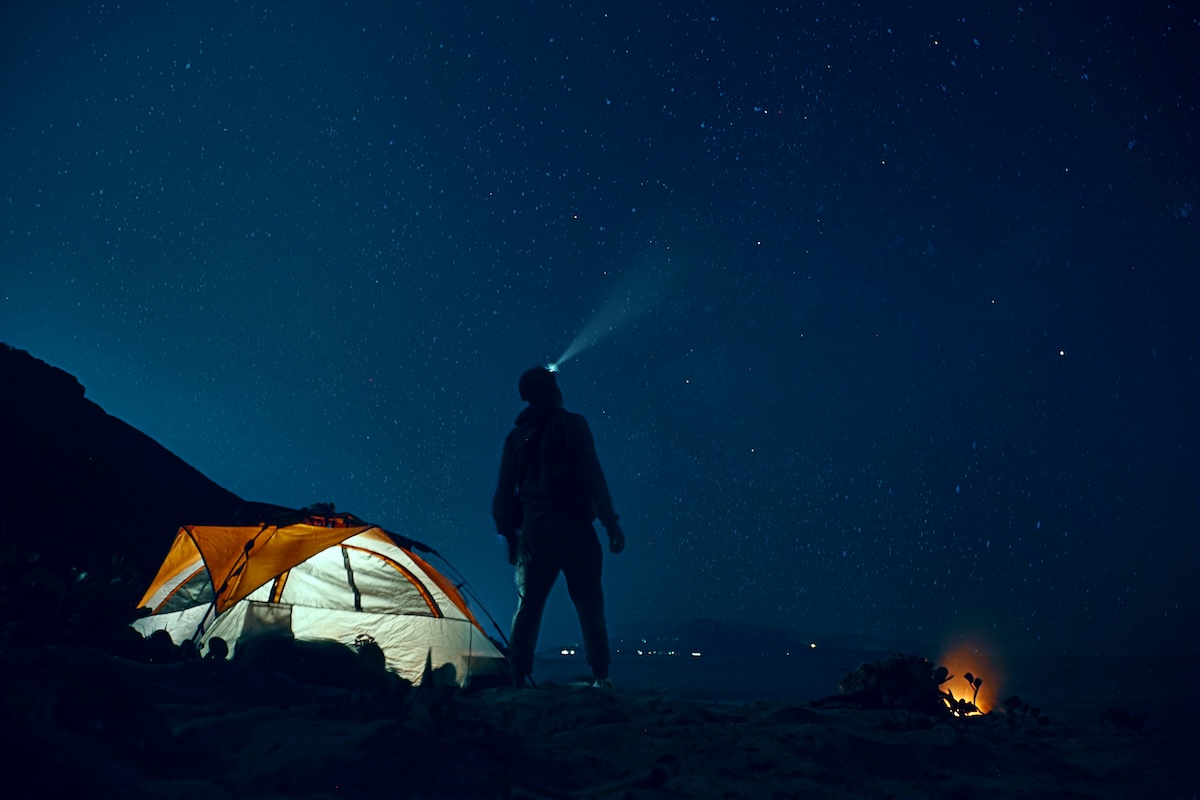
A person camping and stargazing – photo by Rahul Bhosale on Unsplash
Successful desert stargazing trips require specialized equipment beyond standard camping gear:
Optical Equipment
Binoculars: A quality pair of 10×50 binoculars often provides a better initial stargazing experience than telescopes. They show wider fields of view, making constellations and large celestial features easier to locate and enjoy.
Portable Telescope: If bringing a telescope, consider a Dobsonian reflector for the best combination of aperture (light-gathering ability) and portability. The Celestron NexStar 5SE and Sky-Watcher Heritage 130P offer excellent performance while remaining transport-friendly.
Red Flashlight: Standard flashlights ruin night vision that takes up to 30 minutes to develop fully. Use red-filtered lights that preserve your ability to see faint celestial objects.
Navigation and Planning Tools
Star Maps: Both physical planispheres and smartphone apps help locate celestial objects. Popular apps include Stellarium and SkySafari.
Weather Monitoring: Desert weather changes rapidly. Portable weather stations like the Kestrel 3500 provide hyper-local conditions including humidity levels that affect viewing quality.
Celestial Calendar: Plan your trip around celestial events like meteor showers, planet conjunctions, or lunar phases. Websites like Sea and Sky’s Astronomy Calendar track these events year-round.
Comfort and Safety Equipment
Reclining Chair: A zero-gravity chair allows comfortable extended sky viewing without neck strain.
Extra Layers: Desert temperatures often drop 30-40°F after sunset. Pack insulating layers even during summer months.
Hydration System: Dehydration occurs even at night in desert environments. Bring at least one gallon of water per person per day.
Sun Protection: Daytime desert sun causes quick burns. Pack broad-spectrum sunscreen, sun-protective clothing, and wide-brimmed hats.
Photography Equipment
Camera with Manual Settings: Any camera allowing manual control of aperture, shutter speed, and ISO works for basic astrophotography.
Sturdy Tripod: Long exposures require absolutely stable mounting. Carbon fiber tripods offer the best combination of stability and weight.
Remote Shutter Release: This prevents camera shake during long exposures.
Wide Angle Lens: Lenses in the 14-24mm range with maximum apertures of f/2.8 or wider capture the best night sky images.
Desert Stargazing Techniques and Tips
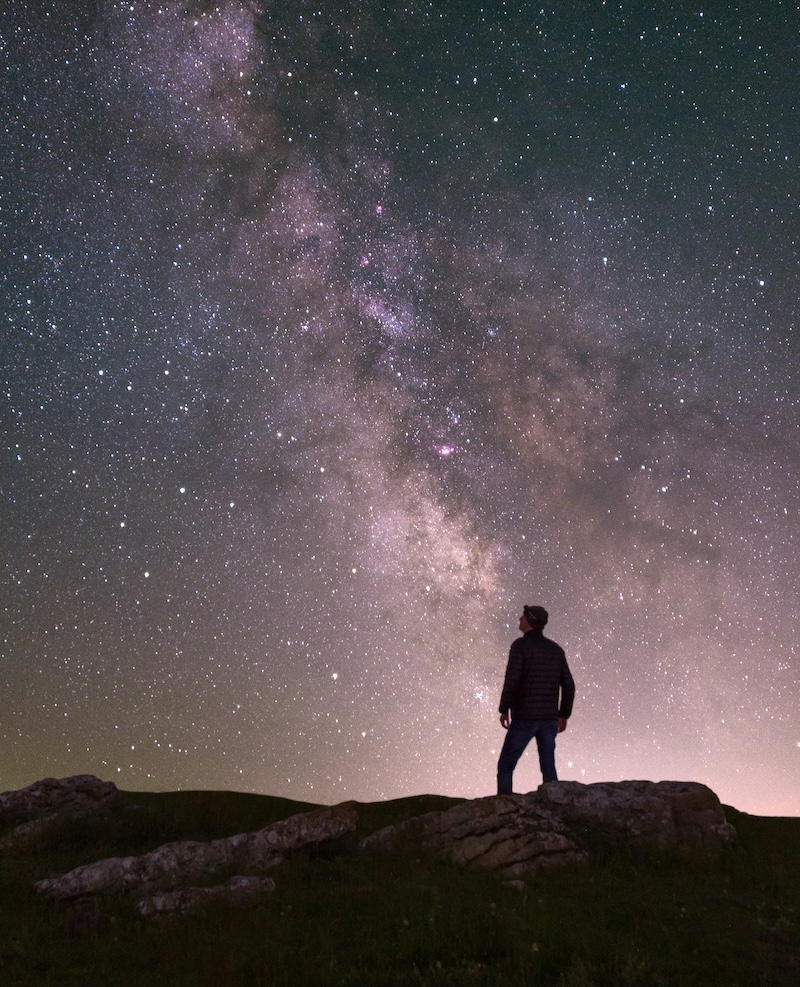
The Milky Way – photo by Chris Klein on Unsplash
Reading the Night Sky
Learning basic celestial navigation enhances any stargazing experience:
Finding North: Locate the North Star (Polaris) by following the pointer stars at the edge of the Big Dipper’s bowl. This serves as both a navigation aid and the center point around which the northern sky appears to rotate during long-exposure photography.
Star Hopping: Master the technique of using bright, easily identifiable stars to locate fainter objects nearby. For example, follow the arc of the Big Dipper’s handle to “Arc to Arcturus” and then “Speed on to Spica.”
Constellation Recognition: Learn the major constellations visible during your trip. Summer desert skies showcase Scorpius and Sagittarius near the Milky Way’s brightest region, while winter highlights Orion and Taurus.
Optimizing Your Vision
The human eye can adapt remarkably well to darkness, but only if you help it:
Dark Adaptation: Allow at least 20-30 minutes in complete darkness for your eyes to reach maximum sensitivity.
Averted Vision: When trying to see faint objects, look slightly to the side rather than directly at them. This technique utilizes the more light-sensitive peripheral rods in your retina.
Limiting Phone Use: Even brief exposure to phone screens destroys night vision. Use apps with night mode settings that convert screens to red light only.
Proper Hydration: Dehydration degrades night vision. Drink plenty of water throughout your desert adventure.
Photographing the Desert Night Sky
Capture the spectacular desert night with these techniques:
Basic Settings: Start with aperture fully open (lowest f-number), ISO between 1600-3200, and shutter speed following the “500 rule” (divide 500 by your lens’s focal length to find the longest exposure before stars begin to trail).
Foreground Interest: The most compelling night sky photos include landscape elements. Use low-level lighting techniques like “light painting” with a red flashlight to illuminate desert features during long exposures.
Focus Technique: Autofocus doesn’t work on stars. Manually focus to infinity during daylight, then tape the focus ring, or use live view magnification on a bright star or distant light to achieve perfect focus.
Stacking Software: Programs like Sequator or DeepSkyStacker allow combining multiple exposures to reduce noise while preserving detail—particularly useful in capturing the Milky Way’s structure.
Desert Camping Safety and Etiquette
Desert Survival Basics
Desert environments demand respect and preparation:
Water Management: Carry more water than you think necessary—at least one gallon per person per day, with additional emergency supplies.
Navigation Redundancy: Cell service remains unreliable in remote stargazing locations. Carry physical maps, a compass, and GPS devices with pre-downloaded maps.
Temperature Preparation: Pack for both extremes—daytime heat and overnight cold. Hypothermia occurs even in deserts when temperatures drop into the 40s°F and below.
Wildlife Awareness: Desert ecosystems host venomous creatures including rattlesnakes and scorpions. Check shoes and gear before use, and keep tent zippers closed.
Minimizing Environmental Impact
Preserve these fragile landscapes for future stargazers:
Stay on Established Paths: Desert biological soil crusts take decades to form and seconds to destroy. Walk on durable surfaces like slickrock or established trails.
Proper Waste Disposal: Pack out all trash, including biodegradable items that decompose extremely slowly in arid environments.
Fire Restrictions: Many desert areas prohibit open fires year-round. Use camp stoves for cooking and battery-powered lights for illumination.
Light Discipline: Keep artificial lighting minimal and red-filtered to preserve the night experience for yourself and others.
Dark Sky Etiquette
Community standards help everyone enjoy the celestial experience:
Arrival Timing: Set up camp well before sunset to avoid using headlights that affect others’ night vision.
Gentle Voice Levels: Sound carries remarkably far in desert environments, especially at night. Keep conversations quiet and music nonexistent.
Shared Equipment: If camping near other stargazers, offer to share views through your telescope or binoculars—but always ask before approaching others’ camps after dark.
Photography Consideration: Coordinate light painting and flash photography with nearby observers to avoid ruining their viewing experience.
Seasonal Desert Stargazing Highlights
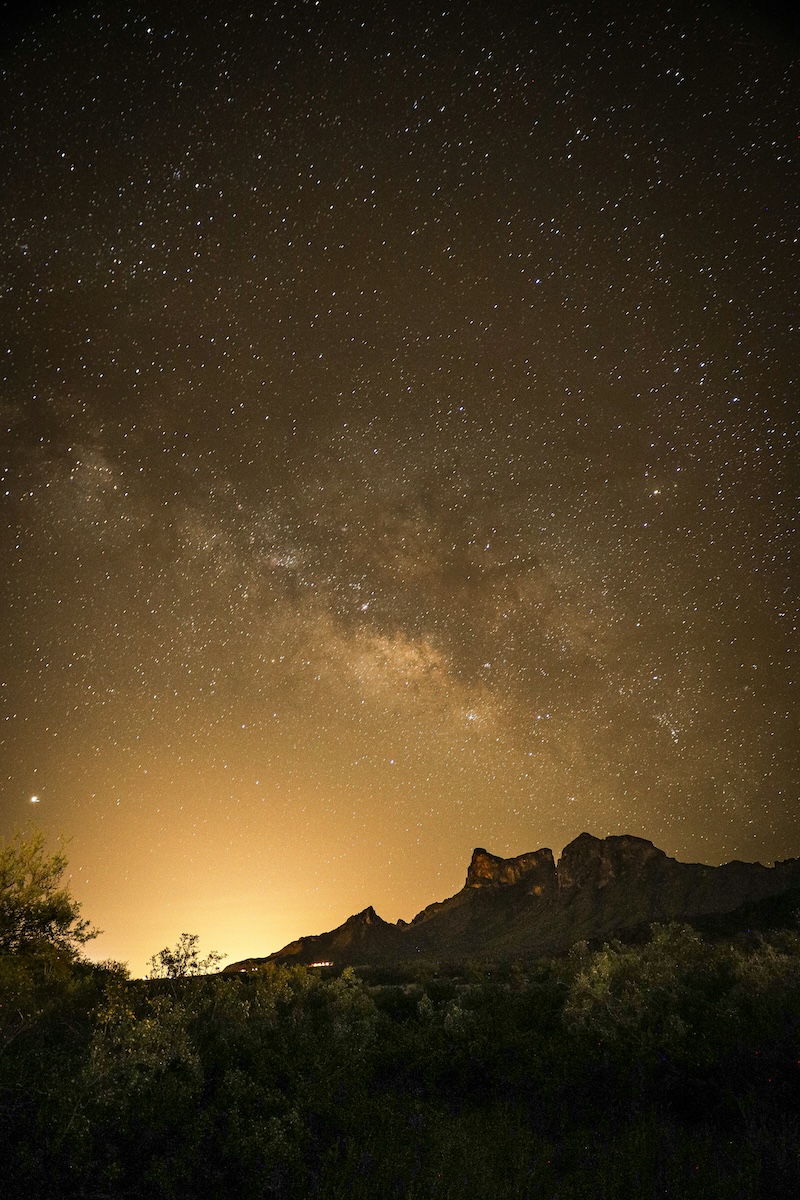
Picacho Peak, Arizona – photo by Frankie Lopez on Unsplash
Each season offers unique celestial features visible from desert landscapes:
Spring (March-May)
Spring evenings showcase Leo, Virgo, and Bootes rising in the east, while winter constellations like Orion set dramatically in the west. The Milky Way remains subtle, hugging the horizon. Planetary groupings often occur during spring months, with Venus, Mars, and Mercury appearing close together shortly after sunset.
Special Events: The Lyrid meteor shower peaks in late April, while the Eta Aquariids (debris from Halley’s Comet) create a show in early May.
Summer (June-August)
Summer brings the most spectacular Milky Way views, with the galactic center rising high in the southern sky. The “Summer Triangle” formed by the bright stars Vega, Deneb, and Altair dominates overhead, while Scorpius and Sagittarius hover above the southern horizon.
Special Events: The Perseid meteor shower creates one of the year’s best celestial shows in mid-August, coinciding with warm desert nights perfect for extended viewing.
Fall (September-November)
Fall evenings feature the Great Square of Pegasus rising in the east while the Summer Milky Way sets in the west. The Andromeda Galaxy becomes prominent, visible to the naked eye under dark desert skies as a fuzzy patch near the constellation Cassiopeia.
Special Events: The Orionid meteor shower in October offers moderate activity with particularly swift and bright meteors.
Winter (December-February)
Winter brings the most striking constellations, with Orion, Taurus, and Gemini dominating the sky. The winter Milky Way appears more subtle than its summer counterpart but reveals delicate structure on clear desert nights. The Pleiades and Hyades star clusters stand out prominently.
Special Events: The Geminid meteor shower in mid-December produces reliable activity even in its early evening hours, while the Quadrantids create a brief but intense show in early January.
Planning Your Desert Stargazing Adventure
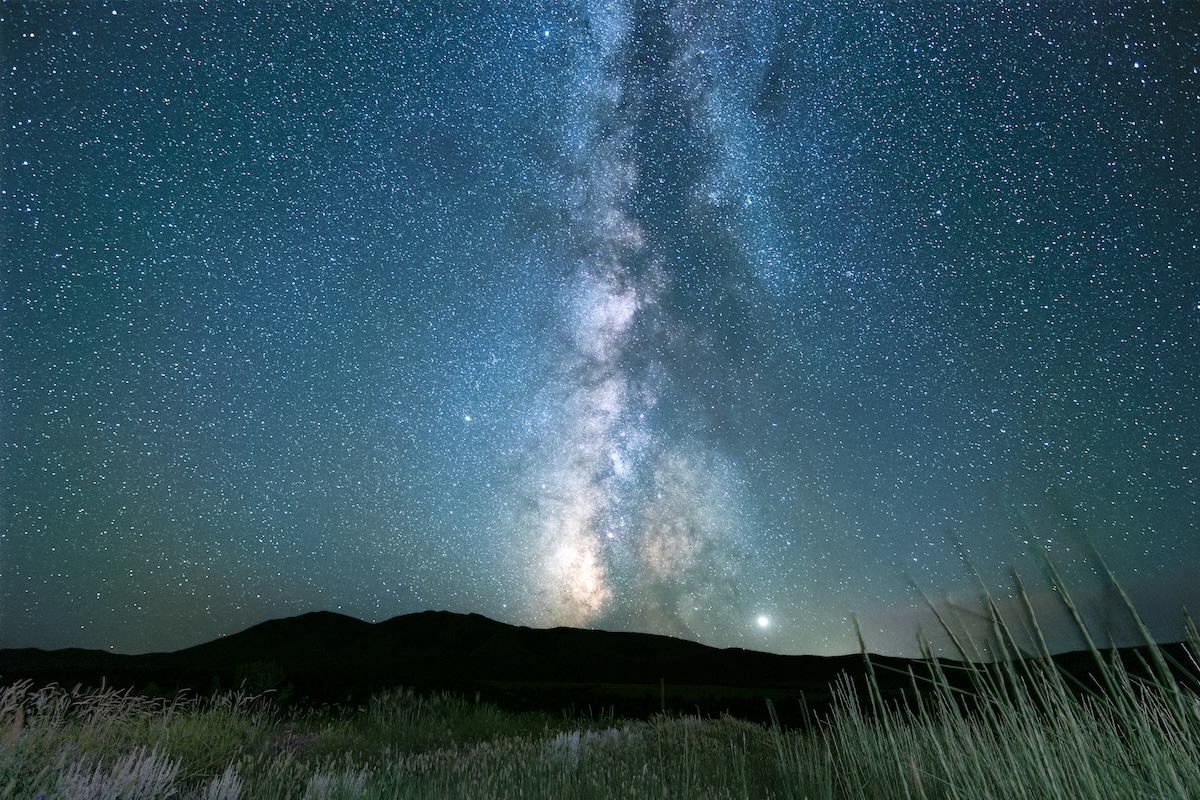
The night sky rising over quiet hills – photo by Jake Weirick on Unsplash
Successful desert stargazing trips balance daytime exploration with nighttime observation:
Trip Duration
Weekend Getaway: Focus on developed campgrounds with reliable access. Create a specific observing plan targeting a few celestial highlights rather than attempting comprehensive sky exploration.
Week-long Adventure: Combine multiple desert locations, moving between them during daylight hours. This strategy allows experiencing different elevations and landscapes while maximizing dark sky time.
Extended Expedition: Consider the lunar cycle in your planning. A two-week trip can capture both dark new moon conditions ideal for deep-sky observation and the illuminated landscapes created by the full moon.
Sample Itinerary: 5-Day Desert Astronomy Trip
Day 1: Arrive at your desert destination by mid-afternoon. Set up camp while daylight remains, prepare equipment, and review star charts for the evening’s highlights. Begin observing with naked eye constellation identification before moving to binocular and telescope viewing.
Day 2: Sleep late after night observations. Spend afternoon exploring nearby trails or visitor centers to learn about the desert ecosystem. Return to camp for sunset and a full night of stargazing, focusing on different celestial targets than the previous evening.
Day 3: Morning photo review and equipment maintenance. Consider a midday campsite change to a new location with different landscape features. Focus the night’s observation on photography or deep-sky objects requiring extended viewing time.
Day 4: Join ranger-led programs if available, or explore different elevation zones within the desert environment. Final night of serious observation with focus on any celestial targets missed on previous evenings.
Day 5: Morning pack-up with daytime drive back to civilization, reviewing photos and observation notes along the way.
Desert Astronomy Events and Communities
Enhance your experience by connecting with organized stargazing events:
Star Parties and Festivals
Many desert locations host annual astronomy events combining organized viewings with presentations by professional and amateur astronomers:
Texas Star Party: Held annually near Fort Davis, this week-long event attracts hundreds of astronomers to the dark skies near McDonald Observatory.
Grand Canyon Star Party: Two simultaneous events on North and South rims bring together astronomy enthusiasts for multiple nights of public viewing each June.
Astronomy Clubs and Volunteer Programs
Local knowledge enhances any stargazing adventure:
Astronomical Leagues: Regional clubs often organize desert excursions with experienced members bringing serious equipment. Most welcome guests at their stargazing events.
National Park Night Sky Programs: Many desert parks offer volunteer opportunities assisting with public astronomy programs, providing access to equipment and expertise.
Citizen Science Projects: Programs like GLOBE at Night allow visitors to contribute meaningful data about light pollution and night sky quality during their desert trips.
Desert stargazing connects us with both ancient human experience and cutting-edge astronomical discovery. Indigenous peoples across the American Southwest developed sophisticated celestial observation systems, using the reliable dark skies to mark seasons, guide planting cycles, and record historical events. When you observe the Milky Way from a desert landscape today, you share an experience nearly identical to that of people who stood in the same spot thousands of years ago.
Modern astronomical research still prizes these same dark sky locations. Major observatories dot the American Southwest desert, from Kitt Peak National Observatory in Arizona to McDonald Observatory in Texas. The same conditions that make your desert camping experience magical—dry air, high elevation, minimal light pollution—drive the site selection for these scientific facilities.
By experiencing the desert night sky firsthand, you join a continuum of human observation stretching from prehistoric sky watchers to future astronomers who will continue unraveling cosmic mysteries under these same pristine desert skies. The stars await.
About the Author
Mike is a writer who researches and shares actionable advice around travel lifestyle, finance, and personal growth. He loves any trip where he can explore the great outdoors, and believes everyone should be able to experience travel for personal development and fulfillment. Read his other articles on Frayed Passport here.Featured image by Ahmed.sellami91 Sellami on Unsplash
Information published on this website and across our networks can change over time. Stories and recommendations reflect the subjective opinions of our writers. You should consult multiple sources to ensure you have the most current, safe, and correct details for your own research and plans.
Frayed Passport is a participant in the Amazon Associates Program, an affiliate advertising program designed to provide a means for sites to earn advertising fees by advertising and linking to Amazon.com. We also may share links to other affiliates and sponsors in articles across our website.

